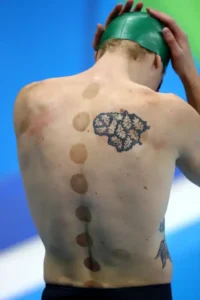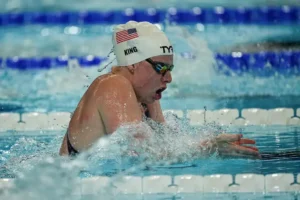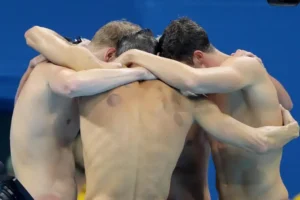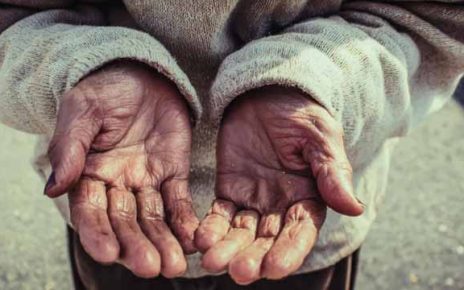The Paris 2024 Games officially commenced on July 27, 2024, with a spectacular opening ceremony held along the Seine River. Approximately 6,800 athletes from 205 different teams participated, boarding various boats to mark the beginning of the event.
Fans who have been following the Olympic Games over the years may have noticed something peculiar about many athletes. Large, dark red circular marks are frequently spotted on their bodies, prompting curiosity and speculation among viewers and fans alike.
These distinctive marks, often seen on the shoulders, back, and other muscle groups, have become common among athletes and some celebrities. But what is the story behind these unusual markings?

While preparing for the Beijing 2008 Olympic Games, Wang Qun was photographed by the swimming pool, her body glistening with water. She donned a sleek swimsuit, its back featuring a criss-cross pattern that revealed prominent, large red circular marks on her skin. A swim cap securely covered her hair, and she sported swimming goggles. Her one hand rested confidently on her waist, ready for her next plunge into the water.
Michael Phelps was pictured celebrating winning the gold in the Men’s 4 x 200m Freestyle Relay at the Rio 2016 Olympic Games. Noticeable round red spots could be seen on either side of his broad shoulders. In another picture, prominent red patches can be seen on Phelps’ abs, arms, and shoulders as he celebrates winning the Men’s 200m Butterfly at the Rio 2016 Olympic Games.

This win also marked his 20th Olympic gold medal. The most decorated Olympian of all time flashed a grin at the cameras as he emerged from the water, the red rings standing out against his damp skin.
The distinctive red circles were visible as Phelps prepared to compete in a Men’s 100m Butterfly heat during the swimming event at the Rio 2016 Olympic Games. He stood tall, confident, and ready, clasping his hands.

A unique overhead shot revealed the striking large red circular marks extended across Michael Phelps’ back. The picture was taken as he prepared to compete in the Men’s 200m Individual Medley Semifinal at the Rio 2016 Olympic Games.

Another endearing picture showed the prominent red patches on Phelps’ back muscles. He and Conor Dwyer were celebrating winning gold in the Men’s 4 x 200m Freestyle Relay Final at the Rio 2016 Olympic Games.
An elaborate photo of Phelps’ posterior torso might lead one to mistake the conspicuous red blotches for bruises on his skin. One such shot was taken as he competed in a men’s 200m butterfly heat at the Rio 2016 Olympic Games.
Alexander Naddour also had a prominent, large red circular mark at the Rio 2016 Olympic Games. The mark stood out on his right arm as he prepared to compete on the pommel horse during the Artistic Gymnastics Men’s Team qualification.
Another swimmer, Ruta Meilutyte, had a visible red circle on her right arm as she competed in the Women’s 100m Breaststroke Semifinal at the Rio 2016 Olympic Games. Meilutyte’s mark was seen again during a vulnerable moment as she appeared dejected after the Women’s 100m Breaststroke Final.
The visible dark red circles on other swimmers’ backs were strikingly uniform at the Tokyo 2020 Olympic Games. A male swimmer, for instance, had four symmetrical circles on each side of his rear torso, creating a visually cohesive pattern. Another swimmer had over 14 striking red discs across her back muscles. The discs were arranged in a linear and well-organized pattern, extending from her back to her arms and shoulders.
Aside from athletes, celebrities such as Jennifer Aniston have been spotted with dark red circles on their bodies. Aniston was seen with these marks at the premiere of “Call Me Crazy” in Los Angeles in 2013. She wore a strapless playsuit, which showed the marks on her upper back. It seemed Jennifer had attempted to cover them with foundation, but the shade was too light and became noticeable under the paparazzi’s flashes.
The eye-catching red rings garnered attention among fans in the Olympics but Gwyneth Paltrow had long been spotted with them, close to two decades ago. At the 2004 premiere of “Anchorman,” the movie star displayed the same distinctive dark red marks on her back as seen on the Olympic athletes. At the time, the images sparked a media frenzy, with publications worldwide writing about the practice that caused the unusual marks on Paltrow’s back.
The unusual round dark red marks are caused by a therapy called cupping. This therapy leaves circular marks that can be mistaken for bruises. The practice, rooted in ancient Chinese medicine, has been employed for at least 2000 years to treat pain, muscle stiffness, and respiratory issues. This therapy involves creating suction in special cups using heat or air, which are then placed on the body. The vacuum pulls the skin and blood vessels towards the cup, often leaving marks on the skin. This process is believed to draw blood to the area, enhancing circulation, and relaxing muscles and joints. There are also suggestions that cupping has anti-inflammatory effects.
High-level athletes worldwide endorse cupping, the technique they credit for their performance. In the US, it is sometimes used alongside acupuncture or massage. While a specialist typically applies the cups, some athletes are doing it themselves.
Phelps has unintentionally become a spokesperson for the practice. Members of the gold-winning US women’s gymnastics team are also among its supporters. Additionally, many in the NBA are enthusiastic advocates or cautious newcomers to cupping.
Swimmers and gymnasts who use cupping therapy claim it helps alleviate soreness in their overworked bodies. Former basketball player Kyle Singler said, “The bruises do look more intense than what they actually feel like. But the benefit from it is really great.” According to Singler, cupping is used primarily for maintenance and recovery. It is an alternative medicine practice. While it doesn’t provide an immediate response, over time, it proved beneficial for recovery and loosening tissue.
Cups used in cupping therapy can be crafted from bamboo, glass, or earthenware. The precise mechanism of cupping remains unclear. However, some researchers propose that placing the cups on specific acupoints on the skin causes increased blood flow or hemostasis, which in turn has a therapeutic effect. Studies have also cited the use of cupping in health issues such as managing cancer pain, low back pain, and acute trigeminal neuralgia. The therapy has also appeared to be effective on acne and facial paralysis.
Therefore, dark red circles on Olympic athletes and other celebrities are not bruises or body décor but evidence of cupping therapy. This practice helps in body recovery and maintenance and offers therapeutic benefits.





